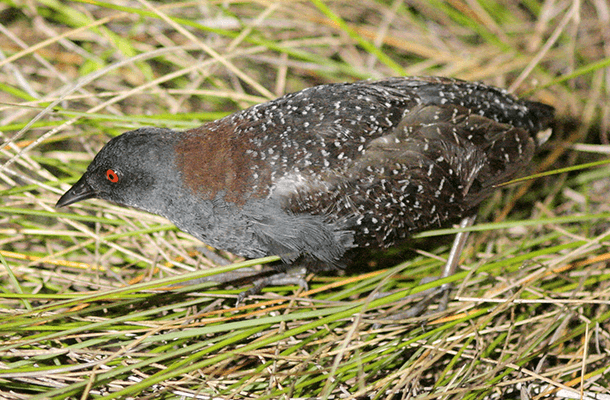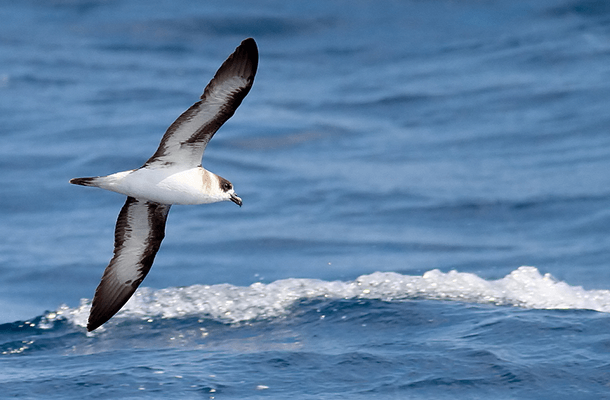Eastern Black Rail and Black-capped Petrel Up for ESA Listing
Contact: Steve Holmer, Vice President for Policy, American Bird Conservancy (ABC). Phone: 202-888-7490 | Email: sholmer@abcbirds.org

The Eastern Black Rail subspecies is being evaluated for listing as "Threatened" under the Endangered Species Act. Photo by Greg Lavaty
(Washington, D.C., October 5, 2018) The U.S. Fish and Wildlife Service (USFWS) announced that the Eastern Black Rail should be considered for the Endangered Species Act (ESA), initiating a year-long listing decision process. The agency also has proposed that the Black-capped Petrel receive Threatened status rather than the more protective Endangered designation.
“ABC welcomes the decision to consider listing the Eastern Black Rail and is committed to working with the USFWS to restore habitats to bring back rail populations under the Endangered Species Act (ESA),” said Steve Holmer, Vice President for Policy at ABC. “The Black-capped Petrel merits greater protection. Endangered status is needed to protect it from all sources of harm in order to halt the species' population slide.”
Eastern Black Rail
The Eastern Black Rail is the smallest and rarest subspecies of North America's tiniest rail. This highly secretive, sparrow-sized bird has a striking appearance, with fiery red eyes, a maroon hind neck, and dark plumage dotted with pearly white back spots. The Eastern Black Rail's range once reached as far north as Connecticut, New York, and Pennsylvania, but in recent years many populations have disappeared. The birds no longer occur north of New Jersey.
“Recent efforts throughout the East indicate that Eastern Black Rail populations are declining, or are extirpated, in at least eight of the Atlantic and Gulf Coast states where they once bred,” said Holmer. “In the last ten to 20 years, reports indicate that Black Rail populations along the Atlantic Coast have declined by as much as 90 percent and have become dangerously low.” Population declines are likely due to continued, widespread development in coastal areas.
Black Rails typically build nests on areas of higher ground in coastal marshes, where flooding is less frequent. This preferred habitat is often eyed for residential or commercial development, occurring as it does along the thin strip of coastline favored by vacationers. Many of the marshes that do remain sit close to development and are subject to factors that reduce habitat quality, including ditching to drain water; predators that tend to follow human development such as rats and cats; and non-native invasive plant species, such as Phragmites, which often crowd out native vegetation and form dense monoculture stands.
The due date for public comment on listing the Eastern Black Rail under the ESA is Dec. 10.
Black-capped Petrel

The Black-capped Petrel has been listed under the Endangered Species Act. Photo by Alfred Yan
The Black-capped Petrel is among the Western Hemisphere's rarest and most secretive seabirds. Extreme habitat loss on its breeding grounds was thought to have driven the bird extinct, until its rediscovery in 1963. This species remains in danger of extinction, with fewer than 2,000 pairs in existence.
On land, Black-capped Petrels face ongoing habitat loss, introduced predators, and artificial lights that may disorient flying birds, causing collisions with trees, wires, and buildings. At sea, commercial fishing vessels pose a potential threat, as the birds may be caught and drown as “bycatch” at baited lines or nets. Offshore energy development and oil spills pose additional hazards.
Although Black-capped Petrels range widely in the Caribbean as well as in Atlantic waters off the East Coast (as far north as New Jersey and New York), their nests are found only in the rugged mountains of one island: Hispaniola, home to the Dominican Republic and Haiti.
As with any rare species, science is the key to conservation success. In 2014, American Bird Conservancy, Grupo Jaragua, and the U.S. Geological Survey tagged three Black-capped Petrels with lightweight transmitters to gather more information on their travels. This tracking data was used to help identify the leading threats to Black-capped Petrels when they are at sea.
Public comment on the species' Threatened designation is invited until Dec. 10; see Federal Register documentation.
###
American Bird Conservancy is dedicated to conserving birds and their habitats throughout the Americas. With an emphasis on achieving results and working in partnership, we take on the greatest problems facing birds today, innovating and building on rapid advancements in science to halt extinctions, protect habitats, eliminate threats, and build capacity for bird conservation. Find us on abcbirds.org, Facebook, Instagram, and Twitter (@abcbirds).


















































